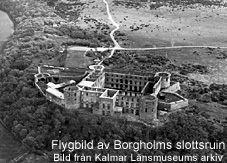Meet the Middle Ages
BackThe Castle of Borgholm

During the end of the 12th century the Crown created strongholds all over the country, particularly so on the borders. Two citadels were built – one in Kalmar and one in Borgholm. The citadel in Borgholm was a sturdy building which measured 16,7 meters across.
In the 13th century a large fortification was constructed around the citadel. During the reign of King Magnus Ladulås the castle was added to, and made into a large fortress with lavish halls where princes and kings could be received and entertained. Outside the castle grounds were the dwellings and workshops of craftsmen and servants. There were also cattle-sheds and stables.
Towards the end of the 14th century, this region experienced time of unrest. Once again, the castle was additionally fortified.
during the Union Wars in the second half of the 15th and at the beginning of the 16th centuries. The castle was besieged by both Swedes and Danes during this period. In July 1361, King Valdemar Atterdag of Denmark, with an army of 2000 men, launched a serious attack on Öland . Borgholm Castle was taken over after a short siege when the entire surroundings with workshops, stables and cattle-sheds were burned down. King Valdemar left 500 or 600 men in charge of the castle and left for Gotland. The battles in 1361 put an end to a peaceful period when the castle was ruled by Duchess Ingeborg Eriksdotter. She was married to Duke Valdemar who had died during the so-called Feast at Nyköping Castle in 1317.
Towards the end of the 13th century, Öland became a castle county under Kalmar Castle. During the period when Duke Valdemar was in power – from the year 1315 – Borgholm was an independent county. It was one of the smaller counties of the country. The people of Öland paid taxes to the bailiff at Borgholm Castle. From time to time they were called upon to do labour there.
After the castle of Borgholm was burned down in 1525, the County of Öland disappeared. Öland once again belonged to Kalmar Castle County.